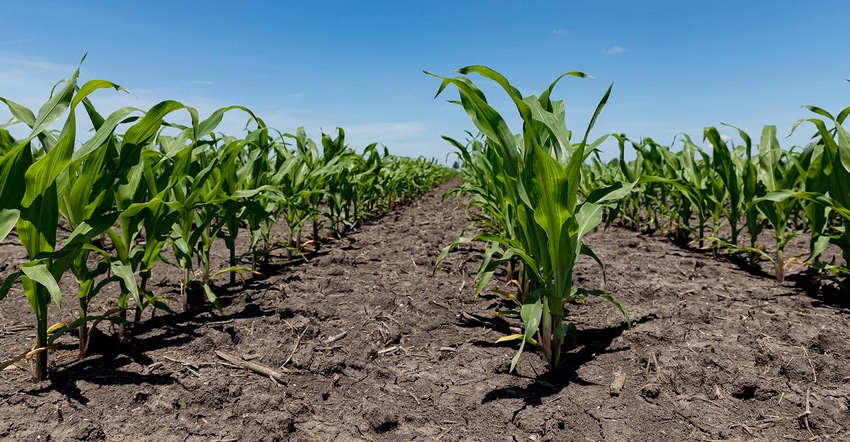
The commodity market has behaved in a strange way of late, especially considering the time of year. With record or near-record yields for both corn and beans, coupled with big acreage, one might think lower prices would be expected - especially with where prices currently reside. However, that’s not what we’ve seen, and my thought is the 2022 crop outlook might be offering more support for current markets than what one may assume.
Snug carryouts
First of all, if we look at the current projections for carry-out for this marketing year we’re in, we’re in a snug situation -- maybe not as tight as we saw last summer, but snug, nonetheless. A 1.5-billion-bushel corn carry-out gives us a 10% stocks-to-usage ratio. Over on the soybean side, a 320-million-bushel carry-out translates to a 7% stocks-to-usage ratio. These levels are not burdensome by any stretch, even though we were looking at tighter levels through much of the past several months.
Further complicating the stocks situation - especially for corn - has been excellent demand so far this marketing year. With ethanol grind building up to this past week’s 2nd biggest ever usage level, many are calling for corn carry to tighten, possibly closer to levels we dipped down to for the 2020-21 marketing year.
Big corn acres?
Given the tight stocks situation, the necessity for big corn acres this next spring has been discussed more of late. There are many issues providing headwinds for a big year for corn acres though. For starters, it’s well-documented we have high-priced inputs, drastically higher than the fall of 2020. The spot price for dry fertilizers are running well in excess of twice the amount we paid last fall, while anhydrous ammonia has tripled.
Fortunately, many producers locked in fertilizer and nitrogen needs at their providers ‘locked-in’ rate that most paid for going into harvest. These prices are substantially cheaper than spot prices.
This brings us to another problem, which is the wet weather much of the corn-belt is experiencing. In much of the eastern-corn-belt, it’s too wet to harvest, so concerns that anhydrous application could be impossible have started to surface.
With weather system after system drenching some fields of late, it’s hard for a producer to feel good about a field with water standing drying up enough - especially at this time of year.
Null and void
So, what does a producer do who can’t get their anhydrous on - many of them with locked-in prices around $700-850 per ton? Well, if it doesn’t get applied by Dec. 1, those contracts are null and void. Given spot prices are currently $1,200-1,300 per ton in many areas of the corn belt, there’s no doubt a huge incentive exists to get the anhydrous applied.
Many may ponder why the producer doesn’t simply wait until spring to apply the nitrogen or look for other sources. The problem with that is the tightness of liquid 28% or urea products is also well-documented. Additionally, the only prices I’ve heard for contracted anhydrous ammonia have been north of $1,500/ton!
When we look at chemicals, both corn and bean producers are looking at major question marks as to whether they can get enough chemical to suit them - and if they do, most are looking at cost per acre going up significantly.
While we’re talking about beans, one has to assume bean acres could go up significantly as beans are certainly less dependent on the price of inputs. At the same time, bean yields continue to impress with another year of many producers seeing record yields, as evidenced by the national yield approaching a record. Given bean net income is as solid as it is, a rise in bean acres, especially with Nov22 beans trading close to $12.50, has to be considered.
Short term outlook
What do I think is possible over the next few months? I know many producers are irritated by how much input prices have gone up, considering many of us are just experiencing the best income year many of us have seen in almost a decade. However, the biggest concern I’m seeing is availability of inputs. With Dec22 corn trading over $5.50, a producer can certainly make money even with high-priced inputs. Will they take the risk though? That is the big question and why myself, along with my buddies at AgMarket, think Dec22 corn will stay well-supported and likely rally versus the Nov22 as we move into the winter/early spring timeframe.
Feel free to reach out to me or anyone on the AgMarket team. We’d love to hear from you.
Reach Matt Bennett at 815-665-0462 or [email protected].
The risk of loss in trading futures and/or options is substantial and each investor and/or trader must consider whether this is a suitable investment. AgMarket.Net is the Farm Division of John Stewart and Associates (JSA) based out of St Joe, MO and all futures and options trades are cleared through ADMIS in Chicago IL. This material has been prepared by an agent of JSA or a third party and is, or is in the nature of, a solicitation. By accepting this communication, you agree that you are an experienced user of the futures markets, capable of making independent trading decisions, and agree that you are not, and will not, rely solely on this communication in making trading decisions. Past performance, whether actual or indicated by simulated historical tests of strategies, is not indicative of future results. Trading information and advice is based on information taken from 3rd party sources that are believed to be reliable. We do not guarantee that such information is accurate or complete and it should not be relied upon as such. Trading advice reflects our good faith judgment at a specific time and is subject to change without notice. There is no guarantee that the advice we give will result in profitable trades. The services provided by JSA may not be available in all jurisdictions. It is possible that the country in which you are a resident prohibits us from opening and maintaining an account for you.
The opinions of the author are not necessarily those of Farm Futures or Farm Progress.
About the Author(s)
You May Also Like






